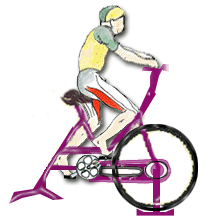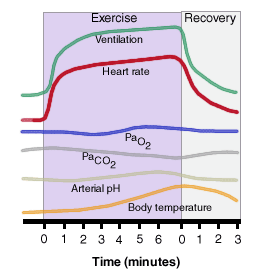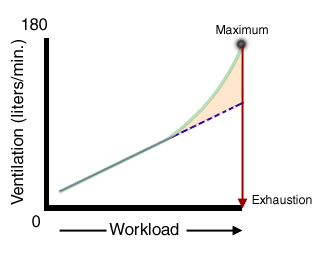|
Exercise Physiology Laboratory |
Respiratory contribution |
| |
During exercise,
ventilation may increase 20 times. The increase does not occur
because of changes in PO2, PCO2 and [H+];
the major stimuli to ventilation during exercise remain unclear.
|
|
|
PACO2 = PaCO2
and PACO2 = VCO2/VA |
|
|
|
During moderate exercise
ventilation increases in the exact proportion to VCO2.
During severe exercise, a person hyperventilates.
Systemic venous PO2 decreases during exercise,
alveolar and systemic PO2 stay at normal levels
because VO2 and VA increases in
proportion.
During very strenuous exercise PaCO2
decreases, but hyperventilation does not produce an increase in
PaO2, but PAO2
increases. In highly trained athletes, PaO2
may decrease.
There is no accumulation of excess [H+] resulting
from accumulation of CO2. During strenuous exercise
there is an increase in arterial [H+] because of
generation and release of lactic acid into the blood; an
increase in [H+] could be a stimulus for increased
ventilation during severe exercise. |
|
 |
 |
|
Respiratory responses to
exercise |
|
Other factors
-
reflex input from mechanoreceptors in joints
and muscles
-
an increase in body temperature
-
stimulation of respiratory motorneurones by
supramedullary inputs
-
an increase in epinephrine concentration
-
an increase in the plasma [K+]
-
a conditioned (learned) response mediated
neuronal input to the respiratory neurons.
|
|
|
|
There is an abrupt
increase in VE at the beginning of exercise, and an
equally abrupt decrease at the end is due to the learned
response to exercise. |
|
|
|
 |
|
Relationship between steady-state
ventilation and workload.
The coloured area indicates that ventilation increases out
of proportion to work loads (hyperventilation) at moderate
to heavy loads. |
|
|
|
To continue with the next section:
muscle, click here |